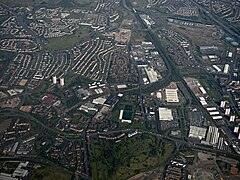
Back Sprinqburn Azerbaijani Springburn Basque Springburn French Allt an Fhuairainn Irish Springburn Dutch Springburn SCO
Springburn
| |
|---|---|
| Inner-city district | |
 View of Springburn from aircraft looking east (2017) | |
Location within Glasgow | |
| Population | 12,064 (2012) |
| OS grid reference | NS607678 |
| • Edinburgh | 65 km |
| • London | 557 km |
| Council area | |
| Lieutenancy area |
|
| Country | Scotland |
| Sovereign state | United Kingdom |
| Post town | Glasgow |
| Postcode district | G21 |
| Dialling code | 0141 |
| Police | Scotland |
| Fire | Scottish |
| Ambulance | Scottish |
| UK Parliament | |
| Scottish Parliament | |
Springburn (Scottish Gaelic: Allt an Fhuairainn) is an inner-city district in the north of the Scottish city of Glasgow, made up of generally working-class households.
Springburn developed from a rural hamlet at the beginning of the 19th century. Its industrial expansion began with the establishment of a chemical works by Charles Tennant on the newly opened Monkland Canal at nearby St. Rollox in 1799, which later became part of the United Alkali Company.
Later in the 19th century, the construction of railway lines through the area led to the establishment of railway works and the village became a parish in its own right. The Garnkirk and Glasgow Railway first opened in 1831 to supply the St Rollox Chemical Works and the Edinburgh & Glasgow Railway was opened in 1842. Later, the City Union Line was extended to Springburn in 1871, and the Hamiltonhill Branch Line opened in 1894.
Initially located outside the Glasgow boundary, the core area was eventually absorbed by the city in 1872 and other parts in 1891. In the early 21st century, it forms part of the Springburn/Robroyston ward under Glasgow City Council.
